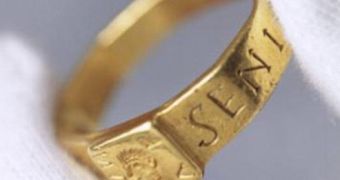Some people might want to pack their bags and head towards Hampshire in a hurry after learning that an ancient Roman ring which allegedly served as inspiration for JRR Tolkien's The Hobbit is now on display in this part of England.
More so given the fact that, by the looks of it, the ring is more than a simple archaeological artifact. Quite the contrary: it is being said that the ring was cursed by its Roman owner, a man named Silvianus, shortly after it was stolen from him by a so-called Senicianus.
“Among those who bear the name of Senicianus to none grant health until he bring back the ring to the temple of Nodens,” reads the tablet on which the curse linked to this ring was inscribed.
This theory is also backed by the fact that, apart from being inset with an image of Venus, the ring has the following words inscribed on it: “Senicianus live well in God.”
This curse tablet was discovered roughly 100 years after the ring was allegedly unearthed by the farmer, yet archaeologists have managed to pin down the connection between these two artefacts.
The ring is set to go on display starting this April 2 at The Vyne, a property owned by the National Trust in Hampshire.
A first edition of The Hobbit and a copy of the aforementioned curse are to also be on display at this exhibition, Sky News informs us.
Despite the fact that strong evidence to support this theory is very much lacking, rumor has it that this ancient cursed ring was first discovered by a farmer in Hampshire towards the end of the 18th century.
Apparently, JRR Tolkien took the time to research the ring just two years before The Hobbit was published, which is why some assume that the story behind this ancient piece of jewelry served as an inspiration for said book.
Thus, archaeologist Sir Mortimer Wheeler is believed to have asked JRR Tolkien for help in figuring out the etymology of the name inscribed on the curse tablet (i.e. Nodens).
The National Trust came to own the ring in the 1930s. Until then, the piece of jewelry is believed to have been the property of the Chute family, who also owned The Vyne.

 14 DAY TRIAL //
14 DAY TRIAL //